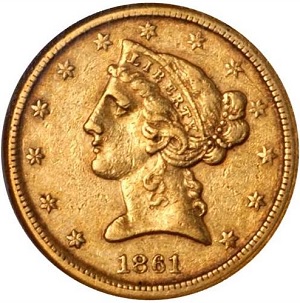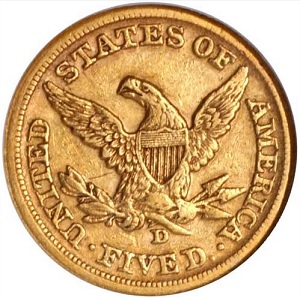1861-D Coronet $5 Half Eagle
The date: April 8, 1861.
The place: The United States branch mint at Dahlonega, Georgia.
The event: Takeover of the mint facility by the Confederate States of America.
Just four days later, the Civil War began when the Confederates opened fire on the federal position at Fort Sumter in Charleston, South Carolina, touching off the most catastrophic chapter in American history.(1)
No coin has a more direct connection to the nation divided by war than the 1861-D Coronet half eagle. That’s because both the U.S. and Confederate governments had a hand in its mintage.(2)
Up until the time of the southern capture, the Dahlonega Mint had coined 1,597 of the 1861-D half eagles. After taking control, the rebels continued striking half eagles, though exactly how many was not recorded. Researchers estimate the number to be in the range of 1,000-2,000 pieces.
Because the same federal dies were used by both the U.S. and the Confederacy, we cannot with certainty distinguish which governing authority struck what coins. However, numismatic scholars have observed that a good number of the 1861-D half eagle surviving population are characterized by poor strikes and off-centeredness caused by misaligned dies. The theory goes that these particular coins were minted by less experienced personnel, as might have been the case after the Confederate takeover.
Gold specialist Doug Winter wrote that at the time of the mint seizure, it is believed there was $13,345 worth of gold bullion at the mint facility. Some of it was used to strike gold dollars and half eagles, both dated 1861-D. Low bullion supplies throughout the wartime South precluded any further coining operations. As we now know, 1861 was the last hurrah for Dahlonega Mint coinage.(3)
The 1861-D half eagle is a cherished possession because of its rarity and status as a front row eye witness in the power struggle between the North and South. Unfortunately, examples of this fascinating issue are typically plagued by problems including heavy abrasions, damage due to unprofessional cleaning, and overall poor eye appeal.(4)
Buying Advice: Good eye appeal, problem-free examples of the 1861-D half eagle are very highly prized by Dahlonega collectors and always inspire robust bidding when the time to sell comes.
PCGS estimates just 75 examples remain of the 1861-D five dollar gold coin.(5) Rare indeed, but as one of most significant half eagles of all time to numismatists and historians alike, this one has consistent multi-dimensional appeal.
| Estimated survivors in all grades: 75 ?
The survivor estimate from PCGS represents an average of one or more experts' opinions as to how many examples survive of a particular coin in all grades. Survival estimates include coins that are raw, certified by PCGS, and certified by other grading services. Learn more at PCGS. |
| PCGS Rarity Scale: 8.2 ?
The 'PCGS CoinFacts Rarity Scale' assesses the relative rarity of all U.S. coins, based on estimated surviving examples. The scale runs from 1.0 to 10.0. The higher the number, the rarer the coin.
Learn more at PCGS. |
| Click HERE to check for availability on eBay** |
Preview of eBay selection (you may find a few more examples of the 1861-D $5 using the HERE link above):
 |
 |
| Trendline Avg = 14.16 | GOOD |
Historic Value Trend Charts:
| Last updated 8-7-24 | Return to Key Date Coin List | |
| Compare to Common Date Coin of Same Type | ||
|
|
||
| Download Charts to Your Computer | ||
Sources
1. Todd, Lewis P. and Curti, Merle. Rise of the American Nation, 3rd ed. New York, NY: Harcourt Brace Jovanovich, Inc., 1972.
2. Stack's Bowers Galleries. 1861-D Liberty Head Half Eagle. Apr 2022 Auction.
3. Heritage Auctions. 1861-D $5. Jul 2022 Auction.
4. PCGS. 1861-D $5 (Regular Strike).
5. PCGS. 1861-D $5 (Regular Strike).
**Many very fine coin dealers sell on eBay. At any point in time, there may be over one million search results for United States coins. This includes quite a few of the recommendations on our Key Date Coin List.
If you’re thinking about purchasing a rare coin, eBay is certainly worth a look. For your convenience, the links from this site to eBay are coded to bring up only coins certified by PCGS and NGC.
As is always, always the case, never buy a valuable coin from a seller whose trustworthiness cannot be verified. Learn more about this at our chapter Best Places to Buy Coins, which also has a section on doing business on eBay.
In the interest of full disclosure, Rare Coins 101 receives a small commission anytime someone connects to eBay from this site and purchases something.
Coin images by Stack's Bowers Galleries.


